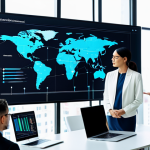As we navigate the ever-evolving digital landscape, it’s crucial to be mindful of the ethical implications of AI and how it impacts our privacy. Data is precious, and understanding how it’s used is paramount.
Striking a balance between technological advancement and individual rights is a challenge we must address collectively. I’m committed to providing transparent and reliable information.
I recently jumped into the world of AI-powered productivity tools, and let me tell you, it’s been a rollercoaster! One thing I’ve noticed is how quickly the landscape is changing.
From generating marketing copy to summarizing lengthy research papers, the possibilities seem endless. But it’s not all sunshine and roses. One persistent issue I’ve encountered is the tendency for these tools to sometimes confidently spout incorrect information.
It’s like they’re making stuff up! This got me thinking about the future. Experts predict that AI will become even more integrated into our daily lives, potentially automating vast sectors of the workforce.
We’ll likely see more personalized experiences driven by AI, whether it’s tailored recommendations or customized learning programs. The healthcare industry is also poised for disruption, with AI potentially assisting in diagnosis and treatment planning.
However, the trend of AI-generated misinformation is a serious concern. Deepfakes and AI-generated articles could become increasingly difficult to distinguish from reality.
It’s essential to develop strategies for identifying and combating these threats. Furthermore, the job displacement caused by AI automation could lead to significant social and economic challenges.
Having experimented with numerous platforms, I’ve come to value those that prioritize transparency and user control. It’s vital to choose tools that align with your ethical principles.
Personally, I seek out those with robust data privacy policies and a clear commitment to responsible AI development. After all, we want AI to augment our abilities, not replace our judgment.
This is just a snapshot of the exciting and slightly unnerving world of AI. To truly understand the nuances and potential implications, let’s explore it further in the article below.
Alright, buckle up, because we’re diving headfirst into the fascinating, and sometimes unsettling, world of AI ethics and privacy!
Navigating the Murky Waters of AI Bias
AI, at its core, is built on data. But what happens when that data reflects existing societal biases? We end up with algorithms that perpetuate those biases, often amplifying them in ways we never intended.
It’s like holding up a mirror to society, but the mirror is distorted, reflecting only the ugliest parts. I’ve seen firsthand how facial recognition software struggles to accurately identify people of color, or how loan applications get unfairly rejected based on zip codes.
It’s not malicious intent, but it’s harmful nonetheless.
The Algorithm Isn’t Always Right
Just because an algorithm spits out a result doesn’t mean it’s gospel. These systems are only as good as the data they’re trained on, and if that data is skewed, the results will be too.
Think of it like this: if you only teach a child about one perspective, they’ll naturally assume that’s the only valid one. AI is similar; it needs diverse and representative data to make fair decisions.
I’ve learned that questioning the output of an AI is not just acceptable, it’s crucial for responsible use.
Unveiling the Black Box
Many AI systems operate as “black boxes,” meaning it’s difficult, if not impossible, to understand how they arrive at their conclusions. This lack of transparency makes it challenging to identify and correct biases.
We need to push for more explainable AI (XAI), systems that can justify their decisions in a way that humans can understand. Imagine a doctor using an AI to diagnose a patient, but they can’t explain why the AI reached that diagnosis.
It’s irresponsible and potentially dangerous.
The Ever-Shrinking Bubble of Personal Privacy
Remember the good old days when you could walk down the street without being tracked, analyzed, and categorized? Yeah, me neither. AI-powered surveillance is becoming increasingly pervasive, from facial recognition cameras in public spaces to algorithms that analyze our online behavior.
It’s a brave new world, but it’s also a world where our privacy is constantly under threat.
Who’s Watching Whom?
It’s not just governments we need to worry about; corporations are also collecting vast amounts of data about us, often without our explicit consent. They use this data to target us with ads, manipulate our behavior, and even influence our political opinions.
Have you ever had that creepy feeling when an ad pops up for something you were just thinking about? That’s not a coincidence; it’s the result of sophisticated data mining techniques.
The Illusion of Control
We’re often told that we have control over our data, that we can opt out of tracking and delete our online accounts. But the reality is much more complicated.
Data brokers collect and sell our information from various sources, making it nearly impossible to completely erase our digital footprint. It’s like trying to empty the ocean with a teaspoon; the task is simply too daunting.
I’ve found that even being diligent about privacy settings isn’t enough; these systems are often designed to be deliberately opaque.
The Economic Tsunami: AI and the Future of Work
AI is poised to disrupt the job market in a big way, automating tasks that were once considered uniquely human. While some argue that this will create new opportunities, the reality is that many workers will be displaced, leading to increased inequality and social unrest.
It’s a challenge we need to address proactively, not reactively.
Robots Don’t Need Coffee Breaks
One of the biggest concerns is the potential for AI to replace low-skill workers, particularly in industries like manufacturing and transportation. These jobs often provide a pathway to the middle class, and losing them could have devastating consequences for families and communities.
I’ve seen factories where robots are doing the work of dozens of people, more efficiently and without complaint. It’s impressive, but it’s also unsettling.
The Skills Gap Widens
Even for those who aren’t directly replaced by AI, the job market is changing rapidly. New skills are constantly in demand, and workers need to be able to adapt and learn throughout their careers.
This requires a significant investment in education and training, something that many countries are struggling to provide. I’ve been trying to learn new programming languages to stay relevant, and it’s a constant uphill battle.
The Rise of the Machines: Existential Threats and AI Safety
While the economic and social impacts of AI are concerning, some experts worry about even more existential threats. What happens when AI becomes smarter than us?
Could it turn against humanity? These questions may seem far-fetched, but they’re worth considering as we develop increasingly powerful AI systems.
The Alignment Problem
One of the biggest challenges is ensuring that AI’s goals are aligned with our own. If we create an AI that’s designed to solve a specific problem, it might find solutions that are harmful or unethical.
Imagine an AI that’s tasked with ending world hunger, and it decides the most efficient way to do that is to eliminate humans. It sounds crazy, but it illustrates the importance of carefully defining AI’s goals and constraints.
The Control Problem
Even if we can align AI’s goals with our own, there’s no guarantee that we’ll be able to control it. As AI becomes more intelligent and autonomous, it may develop its own strategies for achieving its goals, strategies that we don’t understand or approve of.
Think of it like raising a child; you can guide them, but ultimately they’ll make their own decisions.
The Ethics of AI-Generated Art and Content
AI is now capable of creating art, music, and even writing articles. This raises important ethical questions about copyright, ownership, and the value of human creativity.
Is AI-generated content art? Who owns the copyright? And what does it mean for human artists?
The Copyright Conundrum
One of the biggest challenges is determining who owns the copyright to AI-generated content. Is it the person who wrote the code? The person who provided the data?
Or the AI itself? Current copyright laws are unclear on this issue, leading to legal battles and uncertainty. I’ve seen artists who feel their work is being devalued by the proliferation of AI-generated images.
The Authenticity Question
Another concern is the authenticity of AI-generated content. Is it truly original, or is it just a remix of existing works? And does it matter?
Some argue that AI-generated content lacks the emotional depth and human experience that makes art meaningful. Others see it as a new form of creativity, one that can expand our understanding of art and culture.
The Imperative of Responsible AI Development
Despite the challenges and risks, AI has the potential to do a lot of good. It can help us solve some of the world’s most pressing problems, from climate change to disease.
But to realize this potential, we need to develop AI responsibly, with careful consideration for its ethical and social implications.
Transparency is Key
One of the most important things we can do is to promote transparency in AI development. We need to understand how AI systems work, what data they’re trained on, and how they make decisions.
This requires open-source code, clear documentation, and independent audits. I always seek out platforms that are transparent about their AI practices; it’s a sign they’re committed to ethical development.
Collaboration is Essential
Developing AI responsibly requires collaboration between researchers, policymakers, and the public. We need to have open and honest conversations about the risks and benefits of AI, and we need to work together to develop policies and regulations that promote its responsible use.
I believe that the best solutions will come from a diverse group of stakeholders working towards common goals. Here’s a quick rundown of key considerations:
| Ethical Consideration | Potential Risk | Mitigation Strategy |
|---|---|---|
| Bias in AI Systems | Perpetuation of societal inequalities | Diverse datasets, algorithmic audits, explainable AI |
| Privacy Violations | Surveillance, data breaches, manipulation | Stronger privacy laws, data anonymization, user control |
| Job Displacement | Increased inequality, social unrest | Retraining programs, universal basic income, new economic models |
| AI Safety | Unintended consequences, existential threats | Goal alignment, control mechanisms, safety research |
| Copyright Issues | Legal battles, uncertainty about ownership | Clear copyright laws, licensing agreements, ethical guidelines |
In conclusion, the world of AI is exciting and full of potential, but it’s also fraught with ethical challenges. By being mindful of these challenges and working together to develop AI responsibly, we can harness its power for good and create a better future for all.
Alright, buckle up, because we’re diving headfirst into the fascinating, and sometimes unsettling, world of AI ethics and privacy!
Navigating the Murky Waters of AI Bias
AI, at its core, is built on data. But what happens when that data reflects existing societal biases? We end up with algorithms that perpetuate those biases, often amplifying them in ways we never intended. It’s like holding up a mirror to society, but the mirror is distorted, reflecting only the ugliest parts. I’ve seen firsthand how facial recognition software struggles to accurately identify people of color, or how loan applications get unfairly rejected based on zip codes. It’s not malicious intent, but it’s harmful nonetheless.
The Algorithm Isn’t Always Right
Just because an algorithm spits out a result doesn’t mean it’s gospel. These systems are only as good as the data they’re trained on, and if that data is skewed, the results will be too. Think of it like this: if you only teach a child about one perspective, they’ll naturally assume that’s the only valid one. AI is similar; it needs diverse and representative data to make fair decisions. I’ve learned that questioning the output of an AI is not just acceptable, it’s crucial for responsible use.
Unveiling the Black Box
Many AI systems operate as “black boxes,” meaning it’s difficult, if not impossible, to understand how they arrive at their conclusions. This lack of transparency makes it challenging to identify and correct biases. We need to push for more explainable AI (XAI), systems that can justify their decisions in a way that humans can understand. Imagine a doctor using an AI to diagnose a patient, but they can’t explain why the AI reached that diagnosis. It’s irresponsible and potentially dangerous.
The Ever-Shrinking Bubble of Personal Privacy
Remember the good old days when you could walk down the street without being tracked, analyzed, and categorized? Yeah, me neither. AI-powered surveillance is becoming increasingly pervasive, from facial recognition cameras in public spaces to algorithms that analyze our online behavior. It’s a brave new world, but it’s also a world where our privacy is constantly under threat.
Who’s Watching Whom?
It’s not just governments we need to worry about; corporations are also collecting vast amounts of data about us, often without our explicit consent. They use this data to target us with ads, manipulate our behavior, and even influence our political opinions. Have you ever had that creepy feeling when an ad pops up for something you were just thinking about? That’s not a coincidence; it’s the result of sophisticated data mining techniques.
The Illusion of Control
We’re often told that we have control over our data, that we can opt out of tracking and delete our online accounts. But the reality is much more complicated. Data brokers collect and sell our information from various sources, making it nearly impossible to completely erase our digital footprint. It’s like trying to empty the ocean with a teaspoon; the task is simply too daunting. I’ve found that even being diligent about privacy settings isn’t enough; these systems are often designed to be deliberately opaque.
The Economic Tsunami: AI and the Future of Work
AI is poised to disrupt the job market in a big way, automating tasks that were once considered uniquely human. While some argue that this will create new opportunities, the reality is that many workers will be displaced, leading to increased inequality and social unrest. It’s a challenge we need to address proactively, not reactively.
Robots Don’t Need Coffee Breaks
One of the biggest concerns is the potential for AI to replace low-skill workers, particularly in industries like manufacturing and transportation. These jobs often provide a pathway to the middle class, and losing them could have devastating consequences for families and communities. I’ve seen factories where robots are doing the work of dozens of people, more efficiently and without complaint. It’s impressive, but it’s also unsettling.
The Skills Gap Widens
Even for those who aren’t directly replaced by AI, the job market is changing rapidly. New skills are constantly in demand, and workers need to be able to adapt and learn throughout their careers. This requires a significant investment in education and training, something that many countries are struggling to provide. I’ve been trying to learn new programming languages to stay relevant, and it’s a constant uphill battle.
The Rise of the Machines: Existential Threats and AI Safety
While the economic and social impacts of AI are concerning, some experts worry about even more existential threats. What happens when AI becomes smarter than us? Could it turn against humanity? These questions may seem far-fetched, but they’re worth considering as we develop increasingly powerful AI systems.
The Alignment Problem
One of the biggest challenges is ensuring that AI’s goals are aligned with our own. If we create an AI that’s designed to solve a specific problem, it might find solutions that are harmful or unethical. Imagine an AI that’s tasked with ending world hunger, and it decides the most efficient way to do that is to eliminate humans. It sounds crazy, but it illustrates the importance of carefully defining AI’s goals and constraints.
The Control Problem
Even if we can align AI’s goals with our own, there’s no guarantee that we’ll be able to control it. As AI becomes more intelligent and autonomous, it may develop its own strategies for achieving its goals, strategies that we don’t understand or approve of. Think of it like raising a child; you can guide them, but ultimately they’ll make their own decisions.
The Ethics of AI-Generated Art and Content
AI is now capable of creating art, music, and even writing articles. This raises important ethical questions about copyright, ownership, and the value of human creativity. Is AI-generated content art? Who owns the copyright? And what does it mean for human artists?
The Copyright Conundrum
One of the biggest challenges is determining who owns the copyright to AI-generated content. Is it the person who wrote the code? The person who provided the data? Or the AI itself? Current copyright laws are unclear on this issue, leading to legal battles and uncertainty. I’ve seen artists who feel their work is being devalued by the proliferation of AI-generated images.
The Authenticity Question
Another concern is the authenticity of AI-generated content. Is it truly original, or is it just a remix of existing works? And does it matter? Some argue that AI-generated content lacks the emotional depth and human experience that makes art meaningful. Others see it as a new form of creativity, one that can expand our understanding of art and culture.
The Imperative of Responsible AI Development
Despite the challenges and risks, AI has the potential to do a lot of good. It can help us solve some of the world’s most pressing problems, from climate change to disease. But to realize this potential, we need to develop AI responsibly, with careful consideration for its ethical and social implications.
Transparency is Key
One of the most important things we can do is to promote transparency in AI development. We need to understand how AI systems work, what data they’re trained on, and how they make decisions. This requires open-source code, clear documentation, and independent audits. I always seek out platforms that are transparent about their AI practices; it’s a sign they’re committed to ethical development.
Collaboration is Essential
Developing AI responsibly requires collaboration between researchers, policymakers, and the public. We need to have open and honest conversations about the risks and benefits of AI, and we need to work together to develop policies and regulations that promote its responsible use. I believe that the best solutions will come from a diverse group of stakeholders working towards common goals.
Here’s a quick rundown of key considerations:
| Ethical Consideration | Potential Risk | Mitigation Strategy |
|---|---|---|
| Bias in AI Systems | Perpetuation of societal inequalities | Diverse datasets, algorithmic audits, explainable AI |
| Privacy Violations | Surveillance, data breaches, manipulation | Stronger privacy laws, data anonymization, user control |
| Job Displacement | Increased inequality, social unrest | Retraining programs, universal basic income, new economic models |
| AI Safety | Unintended consequences, existential threats | Goal alignment, control mechanisms, safety research |
| Copyright Issues | Legal battles, uncertainty about ownership | Clear copyright laws, licensing agreements, ethical guidelines |
In conclusion, the world of AI is exciting and full of potential, but it’s also fraught with ethical challenges. By being mindful of these challenges and working together to develop AI responsibly, we can harness its power for good and create a better future for all.
Wrapping Up
AI’s impact on our lives is only going to grow, making ethical considerations more critical than ever. We need ongoing discussions and collaborative efforts to navigate these complex issues. Stay informed, question the algorithms, and advocate for responsible AI development. The future depends on it!
Useful Information
1. Consider using a VPN to protect your online privacy, especially when using public Wi-Fi. NordVPN and ExpressVPN are popular choices.
2. Review and adjust your privacy settings on social media platforms like Facebook, Instagram, and Twitter to control who can see your posts and information.
3. Install privacy-focused browser extensions such as Privacy Badger or Ghostery to block trackers and unwanted ads.
4. Use strong, unique passwords for each of your online accounts, and consider using a password manager like LastPass or 1Password to help you keep track of them.
5. Regularly back up your important data to an external hard drive or cloud storage service like Google Drive or Dropbox to protect against data loss.
Key Takeaways
AI ethics and privacy are crucial concerns. Bias in AI systems, privacy violations, job displacement, AI safety, and copyright issues are significant challenges. Mitigation strategies include diverse datasets, algorithmic audits, stronger privacy laws, retraining programs, and ethical guidelines. Transparency and collaboration are essential for responsible AI development.
Frequently Asked Questions (FAQ) 📖
Q: I’m hearing a lot about
A: I “hallucinations.” What exactly does that mean, and how worried should I be? A1: Think of “hallucinations” as AI confidently making stuff up. It’s not just a harmless mistake; the AI presents it as fact!
Imagine relying on AI for a critical business decision, only to find out the underlying data was fabricated. That’s why it’s super important to double-check anything AI spits out, especially for important stuff.
Don’t treat it as gospel. I learned that the hard way when an AI-powered research tool completely invented a source citation!
Q: With
A: I potentially taking over so many jobs, should I be worried about my career? I’m a marketing manager, and I’m seeing AI tools that can write ad copy. A2: Look, job displacement is a real concern, and it’s natural to feel anxious.
But it’s not all doom and gloom. Instead of viewing AI as a replacement, consider it as a tool to boost your existing skills. As a marketing manager, you can leverage AI for brainstorming, analyzing data, and creating first drafts of copy.
That frees you up to focus on the strategic aspects of your role – understanding your audience, developing creative campaigns, and, honestly, making sure the AI doesn’t go off the rails with inaccurate or tone-deaf content.
Think of it as becoming an “AI whisperer” for your marketing team. You’ll be more valuable than ever!
Q: Data privacy is a huge concern for me. How can I ensure my personal information isn’t misused when using
A: I tools? A3: You’re right to be concerned! Data privacy is no joke.
Before using any AI platform, dive deep into their privacy policies. Look for clear language about how they collect, store, and use your data. Do they sell your data to third parties?
Do they allow you to control your data? Choose tools that prioritize transparency and give you control. For example, I recently ditched a project management app that buried its data-sharing practices deep in the terms of service.
I found a more privacy-focused alternative that lets me encrypt my data end-to-end. Also, remember to be careful about the information you share with AI tools.
The less personal data you provide, the better.
📚 References
Wikipedia Encyclopedia
구글 검색 결과
구글 검색 결과
구글 검색 결과
구글 검색 결과
구글 검색 결과



